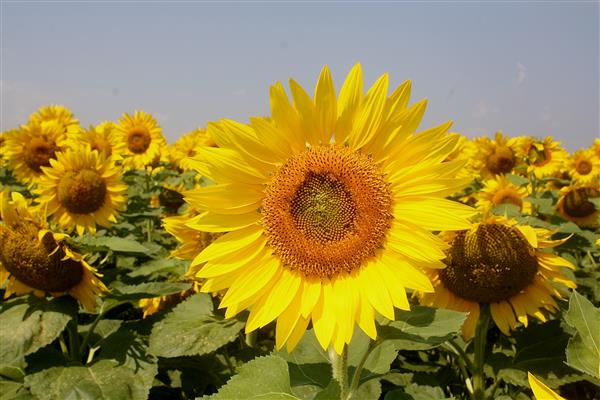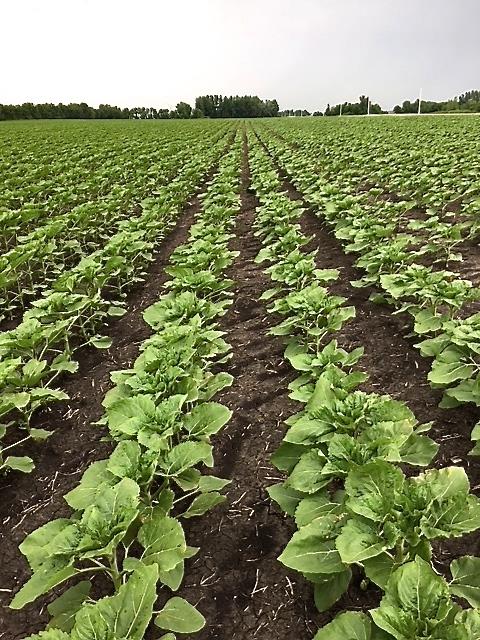Article Archives
Season-Long Sunflower Production Checklist
Friday, January 1, 2021
filed under: Optimizing Plant Development/Yields
 Photo credit: Don Lilleboe
Photo credit: Don Lilleboe
Editor’s Note: The following list of season-long production tips is reprinted, with permission, from a recent edition of SUCCEED, a publication of Nuseed.
Many of these recommendations are “old hat” to veteran sunflower producers, and newer producers may benefit more broadly from a review of these points. But, even long-time producers can use a good reminder now and then.
Hybrid Selection —
• Choose hybrids based on market, herbicide tolerance, maturity and disease tolerance needed on an individual farm.
Planter Basics —
• Consult your planter manual for proper inflation and tire size. Unwanted population variation occurs with overinflation or under-inflation of the meter drive system tires.
• Check closing wheel alignment.
• Check disk openers for wear. For John Deere, Kinze, and White 8000 and older planters, the diameter of a new disk is 15”. A disk worn smaller than 14.5” may create a W in the trench and cause a difference of up to 3/4” in seed depth. White 9000 planters are 16” openers and Case IH planters are 14” openers when new.
• Make sure drives are all in good working order (chains, bearings, shafts).
• Make sure all chains and sprockets are properly aligned to prevent binding.
• Make sure all seed tubes and sensors are clean and functional.
• Row cleaners are vital. They should float freely with maintained pivot point and bearings. Residue left in-furrow can change soil temperature and cause delayed emergence.
Air Seeder Basics —
• Check opener disks for wear—most manufacturers’ disks are 18”; if they are 17” or less, replace them.
• Examine firming and closing wheel arms; check bushings.
• Check the condition of the air delivery system, making sure the air system fan is operating at the proper speed.
• Check all hoses and distributors for wear, air leakage, cracks or blockage.
• Make sure seed boots are within spec (if more than 1/2” is burned off the bottom of the boot, it should be replaced. To check, use your tape measure and if the boot is less than 11.3”, look into replacing the boot.
• Calibrate downforce to ensure the boot is running parallel with the ground (too much downforce will cause the seed boot to run deeper in the trench, and it will not run parallel to the ground).
• Make sure all bearings are in good condition.
• Check that you have the proper metering roll for the proper application. Also, check the metering roll for wear, and clean from any foreign material.
• Check meter calibrations prior to entering the field and check your calibrations and seed usage after planting a few acres.
Before You Plant —
• Early season weed control is crucial. Control early season weeds with soil-applied herbicides to keep fields as free from weeds as possible for the first four to six weeks.
• Utilize seed treatments for below-ground protection of insects and diseases.
When appropriate, plan for and use a registered in-furrow insecticide at planting to control chewing insects.
• Proper seedbed preparation is required prior to seeding sunflower.
• Whether using conventional-till or no-till, an even seedbed promotes uniform germination and emergence and good plant stand establishment.
• A minimum three-year rotation to reduce disease and weed pressure is also recommended. Avoid back-to-back rotation with canola, rapeseed, dry edible beans and soybeans, or other crops susceptible to the same diseases as sunflower. Carefully plan your rotation to control problem weeds and also manage herbicide resistance. Always follow registered uses and label instructions.
• Meet the crop’s specific nutrition requirements and fertilize for realistic targets according to geography, soil type and annual precipitation. Remember, overfertilization can do more harm than good, and fertilizer should never be placed in the seed furrow.
Planting Considerations —
• Soil temperature needs to be at 50° F or more for your chosen soil depth (1.5” to 2.5”). Planting sunflower seed into cold soils may cause seed to go into dormancy, thus resulting in delayed germination.
• If planting deeper than 2”, consider increasing planting population. Percent emergence will decrease as planting depth is increased. Confection sunflower should never be planted deeper than 2”.
• For good seed-to-soil contact, make sure soil is pressed firmly against the seed at planting and the furrow is closed following seed placement. This is important in all crops, but particularly for sunflower. Moisture first needs to get through the woody hull and then to the seed. Poor seed-to-soil contact will result in uneven emergence.
• When planting into no-till, stop and check incrementally that the planter is knifing into the soil. Planting into a field with wet residue can cause “hair pinning”—pushing straw into the seed slot instead of slicing through it. Row cleaners should be able to move residue away from the furrow to prevent hair pinning. With air drills, very little can be done; wait for better conditions.
• Be willing to dig seeds to check placement.
• Be prepared to switch plates, baffle settings, singulator or double eliminator settings and vacuum or air pressure for desired singulation. Revisit settings between seed lots.
• Use a lubricant, such as eFlow 80/20 Seed Lubricant.
• Ensure your vacuum is set properly as your skips and multiples should be close to equal (if more multiples, lower your vacuum; if more skips, increase your vacuum).
• Know the speed at which your planter’s meters operate best for each seed lot. Some lots may require faster or slower speeds than normal.
• Consider filling your planter hoppers half full to reduce bridging potential.
• Because seeding rates are based on commercial grain characteristics desired by specific end-use markets, review the seed company’s seeding rate recommendations for the chosen hybrid.
In-Season —
• Base herbicide decisions on the specific weeds present in fields at time of spraying.
• Use of herbicide-tolerant sunflower hybrids in addition to soil-applied herbicides will result in optimal weed control and help reduce resistant-weed development risk.
• Scout after herbicide spraying to confirm control of target weeds.
• Scout before bloom for rust to manage it in-season.
• Apply fungicide at the R-5 stage on crops infected with 1% or more sunflower rust on upper four leaves.
• Use integrated pest management strategies for optimal insect control. Correct pest identification is key. Scout fields weekly for pests in-season. Scout fields more often (twice per week) as key pests come into critical windows based on an insect scouting calendar.
• Follow correct scouting protocols and base insecticide application decisions on economic thresholds.
• In all regions, seed-boring insects can be controlled with insecticides during the bloom stage.
Pre-Harvest Prep —
• Get the crop off early by applying a desiccant. Natural sunflower drydown can be slow and uneven. By speeding up the drydown process, chemical desiccants can decrease crop losses due to inclement weather, lodging, disease and bird depredation.
• Desiccants can be applied to the crop once plants have reached physiological maturity. At this point, seed moisture is about 35%, the backs of the heads turn yellow, and bracts turn brown in color (R-9 stage). Applying desiccant before this stage may reduce test weight and seed quality. Remember to check local regulations for approved desiccants.
 Harvest —
Harvest —
• Sunflower is ready for harvest when the backs of the heads turn from yellow to brown. Prepare harvest equipment—minor adjustments to combines can make a big difference at harvest.
— Cylinder speeds should range from 300 to 500 revolutions per minute.
— Concave settings should be open.
— Use the slowest cylinder speed with the largest concave opening to reduce seed damage.
— Adjust the fan to accommodate sunflower seeds, which are lighter than other grains, so that air flow keeps only trash floating across the sieve. If fan speed is too high, seeds will be blown out the back of the combine. If fan speed is too low, empties will end up in the grain, which will affect test weight.
• Combine when seed moisture reaches 20% or less — experts recommend 12 to 15%. Seed moisture can be brought under 10% by drying for storage.
• Combine speed should average between five to six miles per hour. However, today’s large combines often need to travel more than five miles per hour to keep full — ground speed should keep the combine full for optimal threshing.
• The target for seeds thrown behind the combine is less than 10 seeds per square foot, which is 100 pounds of actual yield.
• Check test weight when harvesting.
Keep a clean combine to reduce fire risk. Blow the combine down at least twice daily and have fire extinguishers on hand.
Drying & Storage —
• All grain drying fundamentals apply, no matter what method is being used to dry the grain.
• Check drying rates, as sunflower dries quicker than other grains because there are fewer pounds of water to be removed.
• When drying in a high-temperature dryer, constant monitoring is needed as the chaff, lint and other debris associated with sunflower are highly combustible.
• Oilseeds (at 40% oil content) should be stored at 8% moisture; however, that value is determined by the oil content. Oilseeds with higher oil contents (closer to 45%) should be stored between 7 and 8%. Typically, confection and nonoil seeds can be stored short term at 10% moisture content, but for long-term storage growers must dry grain to 9%.
• In storage, monitor grain every couple of weeks when outside temperatures are warm, and every two to four weeks in the winter months.
— Sources —
• Nuseed and Industry Experts
• Nuseed Sunflower Field Guide
• Nuseed Confection Sunflower: Best Practices Guide
• North Dakota State University Sunflower Production Guide